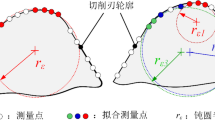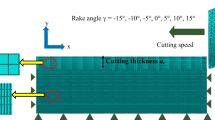Abstract
The Johnson-Cook (JC) constitutive model was utilized to simulate the processing of Al-Si piston alloy ZL109 to obtain the optimal finishing parameters in polycrystalline diamond (PCD) tool, and studied the machining quality of ordinary-turning under the optimized cutting parameters. PCD is brittle, so it is difficult to manufacture orthogonal blades and is easy to break and high cost. We have adopted ordinary-turning quality to verify simulation results. Effect of cutting parameters on residual stress, cutting force and temperature was investigated through simulation, meanwhile, effect of cutting parameters on surface roughness and residual stress was analyzed by experiments. It indicates the verification method is practicable, and residual stress, cutting force and temperature are the smallest in simulation, and the experimental values of surface roughness and residual stress are also the smallest under the optimal cutting parameters, which can guide the cutting parameters selection to obtain higher machining quality.
Similar content being viewed by others
References
D. L. Liu and P. X. Qi, New Aluminum Piston, National Defense Industry Press, Beijing, China (1999).
J. T. Carroll Iii and J. S. Strenkowski, Finite element models of orthogonal cutting with application to single point diamond turning, International Journal of Mechanical Sciences, 30 (12) (1988) 899–920.
S. D. Wang, Finite Element Simulation and Experimental Study on Cutting Process of Medical Titanium Alloy, M.S. Dissertation, Nanjing University of Science and Technology, China (2010).
Z. C. Gong, Research on Optimization of Aluminum Alloy Piston Pin Hole Machining Process, M.S. Dissertation, Shandong University, China (2015).
Z. P. Xu, Research on Key Technology of Dynamic Physics Simulation of Cutting Process based on Finite Element Method, M.S. Dissertation, Shandong University, China (2008).
F. Cus and J. Balic, Optimization of cutting process by GA approach, Robotics and Computer-Integrated Manufacturing, 19 (1) (2003) 113–121.
J. Zhao et al., Tool life study and cutting parameter optimization of ultra-high speed cutting Inconel 718, Journal of Harbin University of Science and Technology, 16 (1) (2011) 9–12.
P. F. Zhao, Research and Development of Hole Machining Cutting Parameter Optimization System, M.S. Dissertation, Nanjing University of Science and Technology, China (2013).
Z. J. Zhou and H. J. Kang, Optimization of tool geometries of PCD tool for turning ZL109 through FEM simulation, Journal of Hunan University of Science & Technology (Natural Science Edition), 32 (2) (2017) 15–21.
A. H. Li et al., Process optimization of aluminum alloy piston pin hole machining process, Manufacturing Technology & Machine Tool, 2 (2018) 33–36.
G. M. Hou et al., Effect of cutting parameters on surface quality in multi-step turning of Ti-6Al-4V titanium alloy, The International Journal of Advanced Manufacturing Technology, 98 (5-8) (2018) 1355–1365.
J. H. Zhang and Z. H. Shang, Sharpening and geometric parameters of PCD cutters for turning silicon-aluminum alloy pistons, Journal of Shandong University (Engineering Science), 35 (5) (2005) 5–8.
Y. Wang et al., High temperature fatigue analysis of ZL109 cast aluminum alloy, Research and Exploration in Laboratory, 139 (10) (2007) 203–205.
J. X. Deng and J. Zhao, CNC Tool Material Selection Manual, Mechanical Industry Press, Beijing, China (2005).
W. Zhang, Factors Affecting the Accuracy of Piston Machining in Internal Combustion Engines, M.S. Dissertation, Xi’an University of Science and Technology, China (2017).
J. Fu, Physical Simulation and Experimental Research on the Cutting Process of Difficult to Cut Metallic Material, M.S. Dissertation, Hunan University, China (2013).
K. L. Li, Mechanical Manufacturing Technology, Shandong Science and Technology Press, Ji’nan, China (2005).
Y. Chen, H. Li and J. Wang, Further development of ox-ley’s predictive force model for orthogonal cutting, Machining Science & Technology, 19 (1) (2015) 86–111.
G. L. Coz and D. Dudzinski, Temperature variation in the workpiece and in the cutting tool when dry milling Inconel 718, The International Journal of Advanced Manufacturing Technology, 74 (5–8) (2014) 1133–1139.
S. Y. Wang et al., Finite element simulation of cutting speed on residual stress on workpiece surface, Tool Engineering, 39 (9) (2005) 33–36.
E. Usui et al., Cutting and Grinding, Mechanical Industry Press, Beijing, China (1982).
A. H. Li et al., Design and simulation of thermal residual stresses of coatings on WC-Co cemented carbide cutting tool substrate, Journal of Mechanical Science and Technology, 30 (8) (2016) 3777–3783.
S. V. Telrandhe, A. K. Saxena and S. Mishra, Effect of microstructure and cutting speed on machining behavior of Ti6Al4V alloy, Journal of Mechanical Science and Technology, 31 (5) (2017) 2177–2184.
S. Masoudi et al., Effect of machining-induced residual stress on the distortion of thin-walled parts, The International Journal of Advanced Manufacturing Technology, 76 (1–4) (2015) 597–608.
O. Fergani et al., Analytical modeling of residual stress and the induced deflection of a milled thin plate, The International Journal of Advanced Manufacturing Technology, 75 (1–4) (2014) 455–463.
T. Jia et al., Study on cutting property of machining aluminum alloy in PCD tool based on orthogonal experiment, Light Alloy Fabrication Technology, 35 (1) (2007) 46–48.
F. Shao et al., Diffusion wear of ZL109 aluminum alloy processed by PCD tool based on thermodynamics, Journal of Tianjin University (Natural Science and Engineering Technology Edition), 43 (4) (2010) 315–321.
Acknowledgments
This work was supported by the National Natural Science Foundation of China (51605260), the Key Research and Development Program of Shandong Province - Public Welfare Special (2017GGX30144, 2018GGX103043) and the Young Scholars Program of Shandong University (2018WLJH57).
Author information
Authors and Affiliations
Corresponding author
Additional information
Recommended by Associate Editor Seok-min Kim
Yonghui Zhou, born in 1973, is currently an Associate Professor at School of Mechanical Engineering, Shandong University, Jinan, China. He received his B.E. degree in chemical machine from Shandong University of Technology, Ji’nan, China in 1994 and his Ph.D. degree in mechanical manufacturing and automation from Shandong University, Jinan, China in 2009. His research interests include high efficient machining & NC tool technology.
Anhai Li, born in 1984, is currently an Associate Professor at School of Mechanical Engineering, Shandong University, Jinan, China. He received his B. E. degree in mechanical engineering and automation from Jilin University, Changchun, China in 2008 and his Ph.D. degree in mechanical manufacturing and automation from Shandong University, Jinan, China in 2013. His research interests include high efficient machining and numerical control cutting tool technology. He is the member of American Society of Mechanical engineers (ASME) and Chinese Mechanical Engineering Society (CMES).
Jun Zhao, born in 1967, is currently a Professor at School of Mechanical Engineering, Shandong University, Jinan, China. He received his B.E. degree, M. E. degree and Ph.D. degree in mechanical engineering from Shandong University of Technology, Jinan, China in 1989, 1993 and 1998, respectively. His research interests include high efficient machining & NC tool technology and multi-axis CNC machining technology of complex curved surface. He is the member of Chinese Mechanical Engineering Society (CMES).
Rights and permissions
About this article
Cite this article
Zhou, Y., Sun, H., Li, A. et al. FEM simulation-based cutting parameters optimization in machining aluminum-silicon piston alloy ZL109 with PCD tool. J Mech Sci Technol 33, 3457–3465 (2019). https://doi.org/10.1007/s12206-019-0640-3
Received:
Revised:
Accepted:
Published:
Issue Date:
DOI: https://doi.org/10.1007/s12206-019-0640-3




